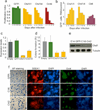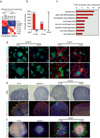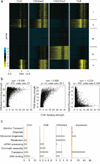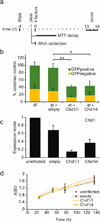Chd1 regulates open chromatin and pluripotency of embryonic stem cells
- PMID: 19587682
- PMCID: PMC3891576
- DOI: 10.1038/nature08212
Chd1 regulates open chromatin and pluripotency of embryonic stem cells
Abstract
An open chromatin largely devoid of heterochromatin is a hallmark of stem cells. It remains unknown whether an open chromatin is necessary for the differentiation potential of stem cells, and which molecules are needed to maintain open chromatin. Here we show that the chromatin remodelling factor Chd1 is required to maintain the open chromatin of pluripotent mouse embryonic stem cells. Chd1 is a euchromatin protein that associates with the promoters of active genes, and downregulation of Chd1 leads to accumulation of heterochromatin. Chd1-deficient embryonic stem cells are no longer pluripotent, because they are incapable of giving rise to primitive endoderm and have a high propensity for neural differentiation. Furthermore, Chd1 is required for efficient reprogramming of fibroblasts to the pluripotent stem cell state. Our results indicate that Chd1 is essential for open chromatin and pluripotency of embryonic stem cells, and for somatic cell reprogramming to the pluripotent state.
Figures





Comment in
-
Stem cells: Escaping fates with open states.Nature. 2009 Aug 13;460(7257):802-3. doi: 10.1038/460802a. Nature. 2009. PMID: 19675633 No abstract available.
Similar articles
-
Stem cells: Escaping fates with open states.Nature. 2009 Aug 13;460(7257):802-3. doi: 10.1038/460802a. Nature. 2009. PMID: 19675633 No abstract available.
-
Gata6 potently initiates reprograming of pluripotent and differentiated cells to extraembryonic endoderm stem cells.Genes Dev. 2015 Jun 15;29(12):1239-55. doi: 10.1101/gad.257071.114. Genes Dev. 2015. PMID: 26109048 Free PMC article.
-
CARM1 is required in embryonic stem cells to maintain pluripotency and resist differentiation.Stem Cells. 2009 Nov;27(11):2637-2645. doi: 10.1002/stem.131. Stem Cells. 2009. PMID: 19544422 Free PMC article.
-
Epigenetic regulation in pluripotent stem cells: a key to breaking the epigenetic barrier.Philos Trans R Soc Lond B Biol Sci. 2013 Jan 5;368(1609):20120292. doi: 10.1098/rstb.2012.0292. Philos Trans R Soc Lond B Biol Sci. 2013. PMID: 23166402 Free PMC article. Review.
-
Epigenetics in embryonic stem cells: regulation of pluripotency and differentiation.Cell Tissue Res. 2008 Jan;331(1):23-9. doi: 10.1007/s00441-007-0536-x. Epub 2007 Nov 15. Cell Tissue Res. 2008. PMID: 18004593 Review.
Cited by
-
The many roles of the conserved eukaryotic Paf1 complex in regulating transcription, histone modifications, and disease states.Biochim Biophys Acta. 2013 Jan;1829(1):116-26. doi: 10.1016/j.bbagrm.2012.08.011. Epub 2012 Sep 6. Biochim Biophys Acta. 2013. PMID: 22982193 Free PMC article.
-
Regulators of pluripotency and their implications in regenerative medicine.Stem Cells Cloning. 2015 Apr 21;8:67-80. doi: 10.2147/SCCAA.S80157. eCollection 2015. Stem Cells Cloning. 2015. PMID: 25960670 Free PMC article. Review.
-
OpenAnnotate: a web server to annotate the chromatin accessibility of genomic regions.Nucleic Acids Res. 2021 Jul 2;49(W1):W483-W490. doi: 10.1093/nar/gkab337. Nucleic Acids Res. 2021. PMID: 33999180 Free PMC article.
-
Transient treatment with epigenetic modifiers yields stable neuroblastoma stem cells resembling aggressive large-cell neuroblastomas.Proc Natl Acad Sci U S A. 2013 Apr 9;110(15):6097-102. doi: 10.1073/pnas.1118262110. Epub 2013 Mar 11. Proc Natl Acad Sci U S A. 2013. PMID: 23479628 Free PMC article.
-
Epigenetic control of cell cycle-dependent histone gene expression is a principal component of the abbreviated pluripotent cell cycle.Mol Cell Biol. 2012 Oct;32(19):3860-71. doi: 10.1128/MCB.00736-12. Epub 2012 Jul 23. Mol Cell Biol. 2012. PMID: 22826438 Free PMC article.
References
Bibliography
-
- Reddien P, Sanchez-Alvarado A. Fundamentals of Planarian Regenaration. Annu. Rev. Cell. Dev. Biol. 2004;20(1):725. - PubMed
-
- Terstappen LW, et al. Sequential generations of hematopoietic colonies derived from single nonlineage-committed CD34+CD38- progenitor cells. Blood. 1991;77(6):1218. - PubMed
-
- Spangrude GJ, Heimfeld S, Weissman IL. Purification and characterization of mouse hematopoietic stem cells. Science. 1988;241(4861):58. - PubMed
Methods Bibliography
-
- Ying QL, Nichols J, Evans EP, Smith AG. Changing potency by spontaneous fusion. Nature. 2002;416(6880):545. - PubMed
-
- Reynolds A, et al. Rational siRNA design for RNA interference. Nat Biotechnol. 2004;22(3):326. - PubMed
-
- Ivanova N, et al. Dissecting self-renewal in stem cells with RNA interference. Nature. 2006;442(7102):533. - PubMed
Publication types
MeSH terms
Substances
Associated data
- Actions
Grants and funding
LinkOut - more resources
Full Text Sources
Other Literature Sources
Molecular Biology Databases
Research Materials
Miscellaneous

